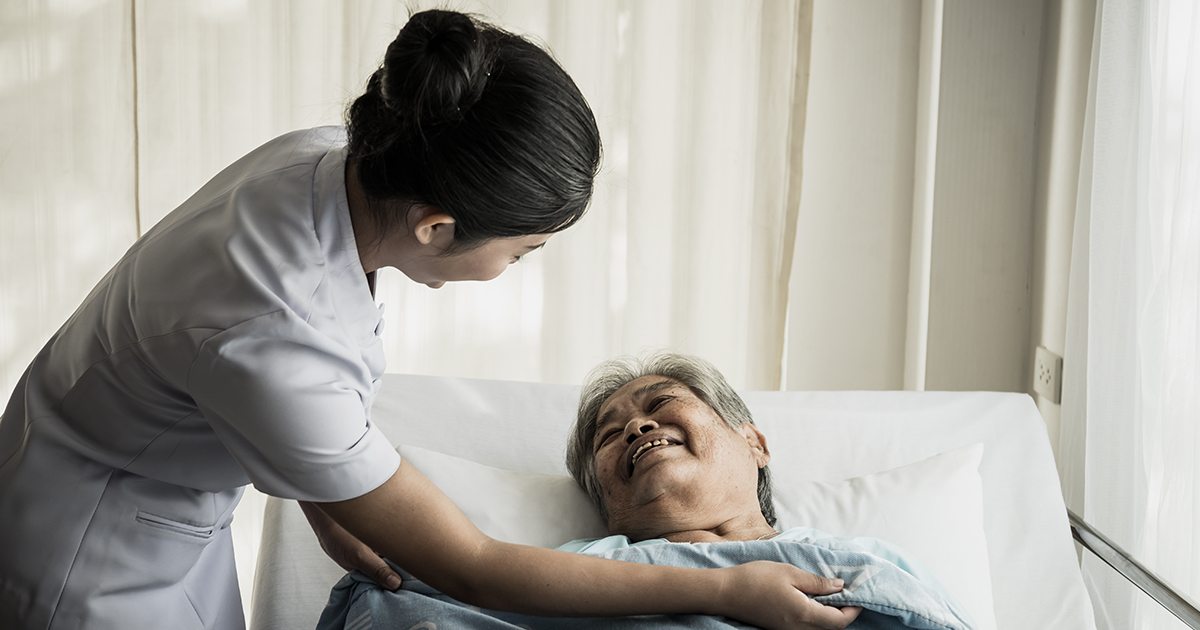Month: January 2018

Nurse Discusses Importance of Pneumonia Vaccine for Mesothelioma Patients and Their Caregivers
People diagnosed with malignant mesothelioma undergo medical treatments that can compromise their already weakened immune system. This leaves them even more susceptible to developing additional illnesses such as pneumonia or the flu. When being treated at a mesothelioma center, immunizations are offered to patients before they start their treatments to help prevent them from getting sicker. These vaccines are usually administered two weeks prior to starting treatments.
Pneumonia is a specific type of lung infection that inflames the air sacs in the lung and causes them to fill with fluid or purulent material. Pneumonia can be caused by bacteria, viruses, or fungi. There is a vaccination for the most common cause of bacterial pneumonia in the U.S., which is caused by the streptococcus bacteria.
The symptoms of pneumonia can be mild to severe depending on the organism involved, your age, and your overall health. Some of the common symptoms of pneumonia are the same as those of a cold or the flu, but tend to last longer. Chest pain when breathing or coughing, a productive cough, fatigue, fever, sweating, shaking chills, shortness of breath, nausea, vomiting or diarrhea are all possible symptoms of pneumonia.
Most kinds of pneumonia are contagious. Both viral and bacterial pneumonia can be spread by inhaling airborne droplets from a sneeze or a cough. It is estimated that about 900,000 Americans get pneumococcal pneumonia every year, and about 5-7% of those infected die from the illness.
Vaccinations for pneumococcal diseases are recommended for all adults over age 65. There are two kinds of pneumococcal vaccines available in the U.S.: Pneumococcal conjugate vaccine- PCV13 or Prevnar13, and Pneumococcal polysaccharide vaccine- PPSV23 or Pneumovax. PCV13 is recommended for all children younger than 2 years old, all adults 65 years or older who have not been previously, and some people with certain medical conditions. PPSV23 is recommended for all adults 65 years old and older, for some people of any age who have certain medical conditions, and for adults who smoke. PPSV23 is recommended to be given at least one year after the dose of PCV13 or Prevnar13.
The pneumococcal vaccine can protect against other diseases caused by the pneumococcal bacteria, such as meningitis, ear and sinus infections, as well as blood poisoning or sepsis. Pneumonia can affect anyone, but two groups are at the highest risk are children aged two or younger, and people aged 65 or older. Anyone who may have a weakened immune system, like mesothelioma patients, are also at risk.
Any caregiver over age 65 should check with their physician about getting vaccinated. Other caregivers who smoke or have other chronic conditions should also check with their physicians about getting the vaccination.
Caregivers need to be reminded that they need to care for themselves as well as their loved ones during this stressful time.

35th Anniversaries of NORD and The Orphan Drug Act
Many mesothelioma patients may not know that every day the National Organization for Rare Disorders has a team of people fighting for them. NORD was established in 1983 to improve the lives of individuals and families affected by rare diseases. This month the organization announced it will be spending 2018 marking 35 years of advocacy.
Not coincidentally, the Orphan Drug Act, that provides incentives to the pharmaceutical industry to invest in developing therapies to help small patient populations, has also reached the 35-year milestone. The Act was created and passed by the hard work of an ad hoc coalition of parents of children with rare diseases who lobbied Congress and the medical and pharmaceutical communities to call attention to rare diseases. After the successful passage of the law, the coalition formed NORD.
“The advances in diagnosis, treatments and care for patients with rare diseases have been remarkable, but we still have many challenges ahead of us,” said Peter L. Saltonstall, President and CEO of NORD, in a Jan. 4 press release announcing the milestone. “The Orphan Drug Act and the creation of NORD brought national attention to rare diseases. The joint anniversaries are an appropriate time for us to recognize the progress made and rededicate ourselves to the needs of the patient community.”
A disease is designated as rare or orphan when less than 200,000 Americans are affected by the disease at any given time. Over 7,000 diseases affect close to 30 million Americans. Mesothelioma is responsible for approximately 3,000 new cases of cancer each year in the U.S. Although there is no cure for mesothelioma, it can be treated with varying degrees of success through the use of surgical procedures, chemotherapy and radiation.
While there is ongoing research to find new treatments or a cure for these orphan diseases, research requires significant amounts of time and money. Since many of these illnesses affect so few people, researchers and pharmaceutical companies do not find it beneficial to expend the time, effort or money to find treatments and cures. Although the Orphan Drug Act has helped in the development of some treatments, still less than 500 of the orphan diseases have an approved treatment, according to NORD.
Some of the milestones NORD highlights from its 35-year history include:
- Named a 4-star charity by Charity Navigator, one of the 100 Best Charities by Worth Magazine, and “Charity of the Week” by The Week Magazine;
- In at least two instances, NORD’s rare disease research grant program has resulted in FDA-approved orphan therapies;
- NORD established a Natural History Study program and entered into a cooperative agreement with FDA to further rare disease research.
Since inception of the Orphan Drug Act, the FDA has approved more than 600 orphan products and 4,000 orphan drug designations. The Orphan Drug Act, according to NORD, is credited with helping to drive innovation in cancer treatment and gene therapies.
“The Orphan Drug Act is just as important today as it was in 1983,” Saltonstall said. “This year, we will be saluting the progress made to date, we will also be focusing on the fact that much remains to be done.”

Improving Immune System’s Memory May Lead to New Mesothelioma Treatment
Mesothelioma patients often lose ground when fighting back against the deadly cancer due to a compromised immune system. Immunotherapy is one way oncologists and researchers use to awaken the immune system so it can successfully fight the cancer. Now, researchers report they may be able to stimulate the immune system’s ability to “remember” infections leading to new treatments that may better help fight disease.
Researchers from Monash University in Australia report they have discovered a “novel molecular ‘blueprint’” that could be the key to immunological memory, according to a Dec. 20 press release from Monash University’s Biomedicine Discovery Institute. The team found that when the immune system fights an infection, the B and T cells create memory cells. This memory is how immunity is developed and how vaccines work by mimicking that immunity.
B cells generate antibodies, whereas T cells are known as killer cells and destroy the invading sick cells. Using a strain of the flu, the researchers found the T cells, that the team called hit men, “are genetically wired to behave” the way they do. This finding broke new ground in understanding the changes T cells undergo when fighting an illness.
“What we found is there’s a specific sort of wiring that seems to characterise this type of immunological memory – it’s like an electrical circuit,” Professor Turner said. “We were able to identify specific ‘switches’ that are used in parts of the genome that actually give T cells their function.”
Mesothelioma, a signature cancer of asbestos, is extremely aggressive, and the cancer cells continue to grow and multiply as the patient’s immune system is compromised. Finding a way to wake up the immune system is critical for extending survival. Immunotherapy has been used successfully in some mesothelioma patients, however, this research points to another way to engage the immune system. In fact, Turner said, the “blueprint could serve as a benchmark for research, and potentially be used to hone and personalise therapies.”
Understanding immunological memory may help them improve existing treatments or create new ones that use the immune system to fight cancer, the researchers concluded.
The team will continue this research and reports the next step is to use the human influenza virus next.
Read the full study in the Dec. 19, 2017, issue of Cell Reports.

The CARE Act Supports Mesothelioma Caregivers
For many years we have had the privilege of accompanying patients and family members along their journey with mesothelioma. We have witnessed incredible courage and resilience by the patients and the caregivers during their unique journeys with this deadly cancer. Family caregivers are often a vital part of the team. Beginning with the mesothelioma diagnosis, the family caregiver often has to navigate the new and confusing world of medicine.
One of the most confusing times in a patient’s medical care is the transition from the hospital to home. Often the discharge instructions are confusing, and patients and families do not understand all that is involved in safely transitioning home. In the U.S., “informal caregivers” provide many hours of unpaid care for their loved ones.
Caregivers in the U.S. include family members who have no formal training in performing the tasks involved in a patient’s care. For patients with malignant mesothelioma, the journey cannot be done by the patient alone. Help is required. Family care giving can be an overwhelming task that can consume the patients’ caregivers, physically, financially, and emotionally.
The vital role that “informal caregivers” play in the health and well-being of all patients has recently been acknowledged. Organizations offering support and tips for caregivers include the American Association of Retired People- AARP (http://www.aarp.org/), and the Family Caregivers Alliance (http://www.caregiver.org/). Together, and with other organizations, they have supported and help passed The Care Act.
In November 2017, the Care Act was passed in Massachusetts. The Caregiver Advise, Record, Enable (CARE) Act supports family caregivers. When their family members go to the hospital and transition home the law requires that the patient will be able to designate a caregiver. The caregiver will have to be notified when your loved one is being discharged to home or to another facility. The tasks that are required to safely care for your loved one will need to be explained to the caregiver before transitioning home. Some of the examples of what will need to be explained and demonstrated are, medications, treatment of wounds, injections.
It is well known that the glue that holds a patient’s experience together is an unpaid family caregiver. They provide care for their loved ones in an attempt to keep them out of the hospital. Hopefully, The Care Act will help them and their loved ones make the journey a little less confusing.
The CARE Act has been signed into law in 36 states, the District of Columbia, Puerto Rico, and the U.S. Virgin Islands. Find out more about the CARE Act at AARP.org.

Libby, Montana Mesothelioma Doctors Contribute Knowledge to Medical Journals
The doctors at Libby, Montana’s Center for Asbestos Related Disease (CARD) know a thing or two about mesothelioma. The town is home to a vermiculite mine blamed for widespread contamination from asbestos exposure and for hundreds of cases of mesothelioma, and CARD has been the hub for care and screening of many of the patients. Now, the medical team is sharing their knowledge of this deadly disease through collaboration on articles for scientific journals.
Dr. Brad Black and Dr. Gregory Loewen, both physicians at CARD, were among the authors in two separate studies published recently in the peer-reviewed journals Inhalation Toxicology and the Journal of Occupational and Environmental Medicine (JOEM), according to a Dec. 29 article in The Western News. The two provided their expertise into the studies looking at the pulmonary function of miners at Libby’s vermiculite mine.
In the study of 256 individuals who worked at the mine for a minimum of six months, the researchers concluded “eighty-seven percent of miners exposed to Libby Amphibole had pleural abnormalities on CT [computed tomography].” The study was published in JOEM.
“… most doctors probably don’t know about this unique type of asbestos related disease and wouldn’t be able to recognize it in their patients if they didn’t hear about it,” said Dr. Black on why the study is important.
The W.R. Grace vermiculite mine and mill located in Libby, closed since 1990, was found to have an asbestos deposit in the mine and is the site of significant asbestos exposure. According to reports, nearly 3,000 residents and former miners have been diagnosed with an asbestos-related disease, and over 400 have died from mesothelioma. Contamination from the site led the federal government to declare Libby a health emergency.
Asbestos is a known carcinogen and is proven to cause mesothelioma, a serious cancer caused by breathing in the asbestos fibers that then become lodged in the thin membrane that lines and encases the lungs.
The second study followed one individual who worked at the mine from 1969 to 1990 and had no other known exposure to asbestos. The person developed “asbestos-like” pathological features and eventually an adenocarcinoma. According to the authors, “This is to our knowledge the first time such an extensive evaluation has been conducted in a vermiculite miner from Libby, Montana.”
About CARD
CARD’s primary goal is to provide specialty healthcare and screening to those affected by Libby Amphibole Asbestos. CARD’s secondary goal is to stimulate research from around the country to gain further understanding of disease mechanisms, improve early disease and cancer detection and intervention, and develop effective health management strategies in hope of finding answers to improve health outcomes for individuals and communities.
Find out more about the Center for Asbestos Related Disease on its website.
Read the studies in the Dec. 1 issue of the Journal of Occupational and Environmental Medicine and in the Oct. 17 issue of Inhalation Toxicology.
Sources:
- Center for Asbestos Related Disease
http://www.libbyasbestos.org/ - Inhalation Toxicology
http://www.tandfonline.com/doi/abs/10.1080/08958378.2017.1372536 - Journal of Occupational and Environmental Medicine
http://journals.lww.com/joem/pages/default.aspx
- The Western News
http://www.thewesternnews.com/front_page_slider/20171229/libby_asbestos_clinic_contributes_research_to_two_journals

Free Mesothelioma Patient & Treatment Guide
We’d like to offer you our in-depth guide, “A Patient’s Guide to Mesothelioma,” absolutely free of charge.
It contains a wealth of information and resources to help you better understand the condition, choose (and afford) appropriate treatment, and exercise your legal right to compensation.
Download Now